The Google Nexus 6P Review
by Andrei Frumusanu on December 16, 2015 8:00 AM ESTSoftware UI
In terms of software the 6P is able to sport the latest Android 6.0 Marshmallow, courtesy of course of being a Nexus device. There’s not terribly much to say about the OS that hasn’t been said already by Brandon’s analysis in the review of the Nexus 5X. This is due to the fact that all Nexus devices come equipped with the same software experience, but also due to the fact that Android 6.0 offers very little front-facing changes.
I’ll openly admit that I’m not too much of a fan of the stock Android experience: Over the years Google’s stock Android has always been praised as the “pure” experience and how Android should be. I find this a bit unfortunate as I find there’s a lot of usability flaws in the stock. It’s the simple things that most other OEM skins add that I find the most lacking in stock Android, examples being the lack of an auto-brightness toggle in the quick settings or even having a brightness slider directly available in the notification shade itself which reduces the motions to get to the settings.
My biggest gripe however are the navigation buttons and Google’s lack of an option to reorder them. While I understand the design decision and logic behind having a back button on the left, it makes no sense in terms of usability for the majority of people that are right-handed. The back button is by far Android’s most used navigation button, so I found the Nexus 6P’s larger size to exacerbate the issue as I need to always change grip or stretch my thumb to able to reach it properly. Still having this huge ergonomics issue after this many years is basically inexcusable – the notion that it’s more intuitive to have it on the left is a poor rationale as “unintuitive” use-methods can be learned and taught, but my thumb stopped growing a long time ago and I imagine so did everybody else’s. Virtually all OEMs recognize this issue and either come by default with reversed navigation buttons or by at least offering the option to rearrange them. Here’s hoping that Google listens and adds this as a stock option for future Android releases, similarly how they did for many other past features that were pioneered by third-party vendors.
Ambient display is a great feature that takes advantage of the 6P's AMOLED screen. Every time you pick up the device it will show you a minimalistic greyed out view of your current notifications without having to press any buttons. The detection is a bit finicky and sometimes goes off too easily as I often saw ambient display trigger itself while the device was just laying steadily on my table, and also sometimes when you do want it to go off when you pick up the device it might decide not to. However when it does work it works well, and it also enables you to directly unlock the phone from there. I do wish the display period had been configurable as sometimes where you have a lot of notifications the screen will go back off before you can read all of them.
Other than some of the aforementioned annoyances, the stock Android experience is a good one. In terms of performance, there were some concerns that I’ll reiterate in the PCMark writing sub-test but otherwise the device is fluid as you’d expect it to be. I may be biased when saying this but I just don’t think stock Android is an “exciting” experience or a platform where we see lots of innovation. I’m aware that there are groups who vehemently adhere to Google’s design decisions, but for me personally it just doesn’t do it as it comes with too many daily usability regressions.
NAND Performance
In terms of NAND storage, the Nexus 6P uses a Samsung eMMC module. In fact, this is the same “BGND3R” variant as found in this year’s HTC One M9. For testing I also ran the NAND benchmarks on an unencrypted data partition to be able to analyze Android’s full disk encryption overhead that is now obligatory for all new devices shipping with 6.0 Marshmallow.
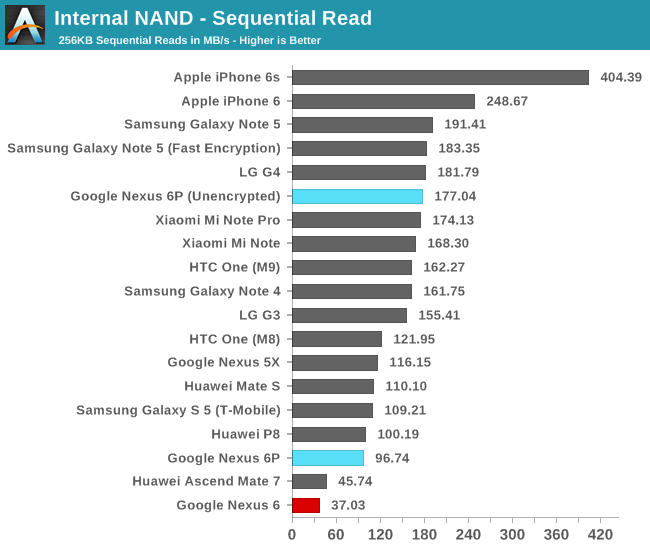
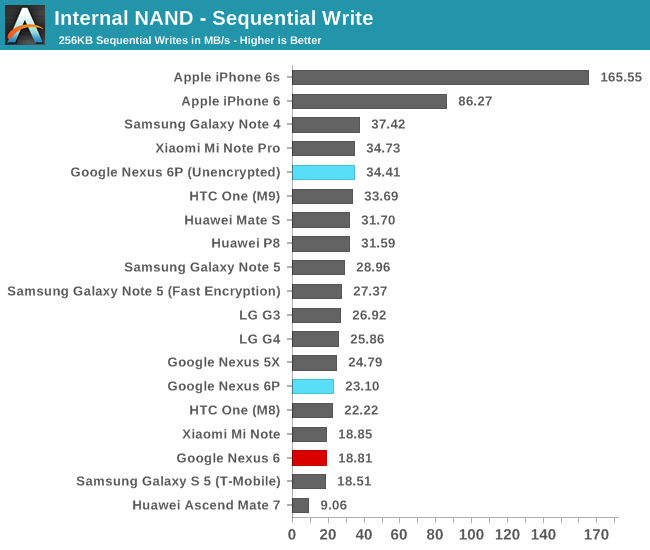
As we can see the unencrypted numbers perform as expected and within range of the HTC One M9’s performance. The encrypted numbers which come as default with the device are the more concerning ones as we see a decrease in read performance of up to 84% and write performance decreases by 43%.
The Nexus 6P uses software decryption, accelerated by ARMv8 cryptography instructions. Google claims that this method is actually faster than using Qualcomm’s Snapdragon built-in SoC dedicated hardware crypto unit, which points out to a possible severe lack of performance and readiness on the part Qualcomm's SoC. We were curious to determine if this was solely an issue for Qualcomm and re-did some encrypted and unencrypted runs on the Note 5 and found that the overhead of encryption on that platform is very minimal, pointing out to that the degradation seems to be limited to Qualcomm's SoCs. It would be interesting to see if the Snapdragon 820 will be able to offer improvements in this regard.
In the end, the Nexus 6P’s out-of-the-box performance on the encrypted data partition seems very lackluster and it may affect application speed. One has to remember that it’s only the data partition that is encrypted, as we see no degradation on the internal or system partitions as they remain unencrypted.
WiFi Performance
The Nexus 6P comes naturally with 802.11ac WiFi in 2x2 MIMO configuration, all powered by Broadcomm's BCM4358 WiFi SoC. This is the same chipset found in other devices such as the Galaxy S6, so hopefully performance will be similar.
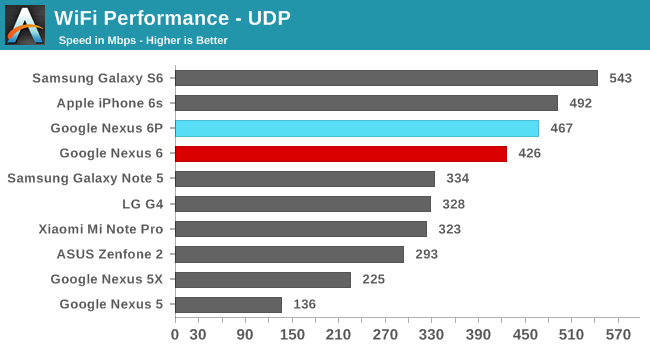
And indeed we see excellent WiFi performance from the 6P as we reach up to an average of 467Mbps, up there among one of the fastest WiFi implementations in today's smartphones.


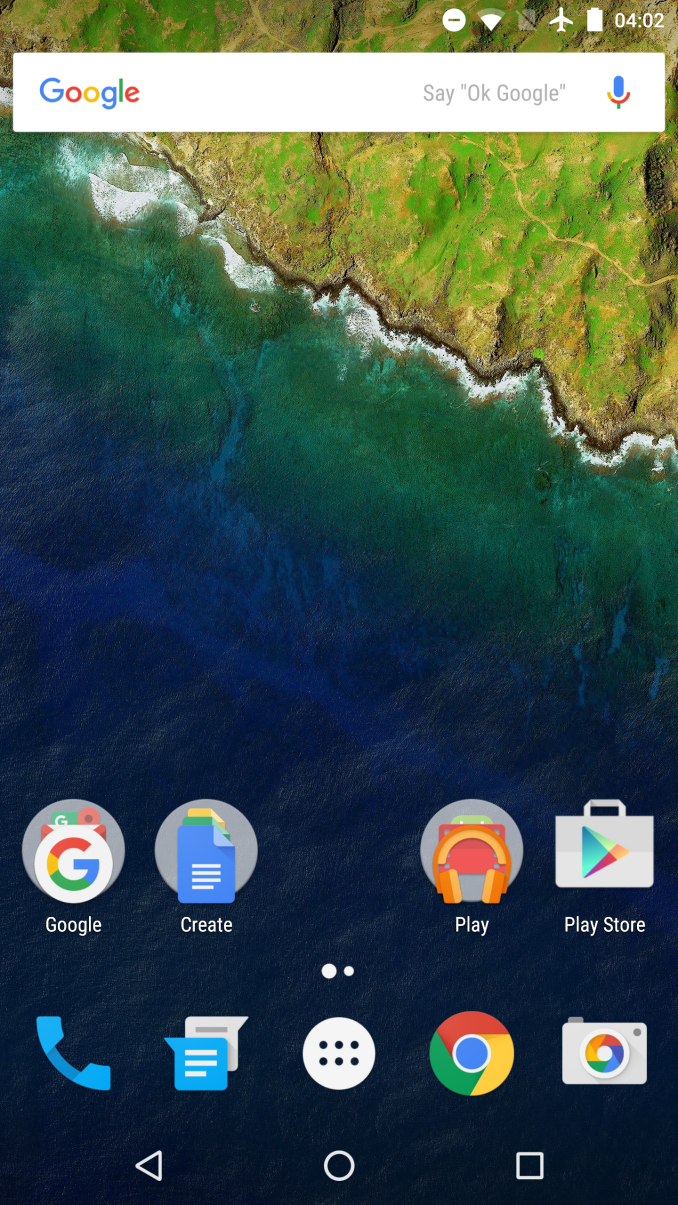
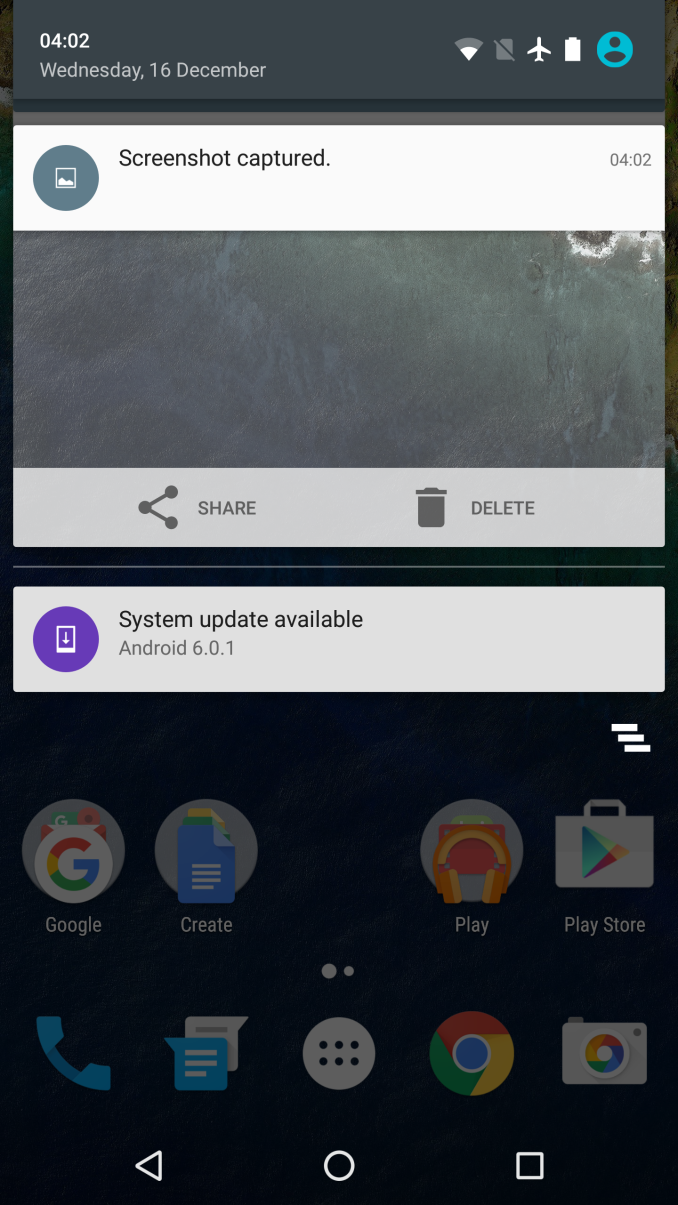
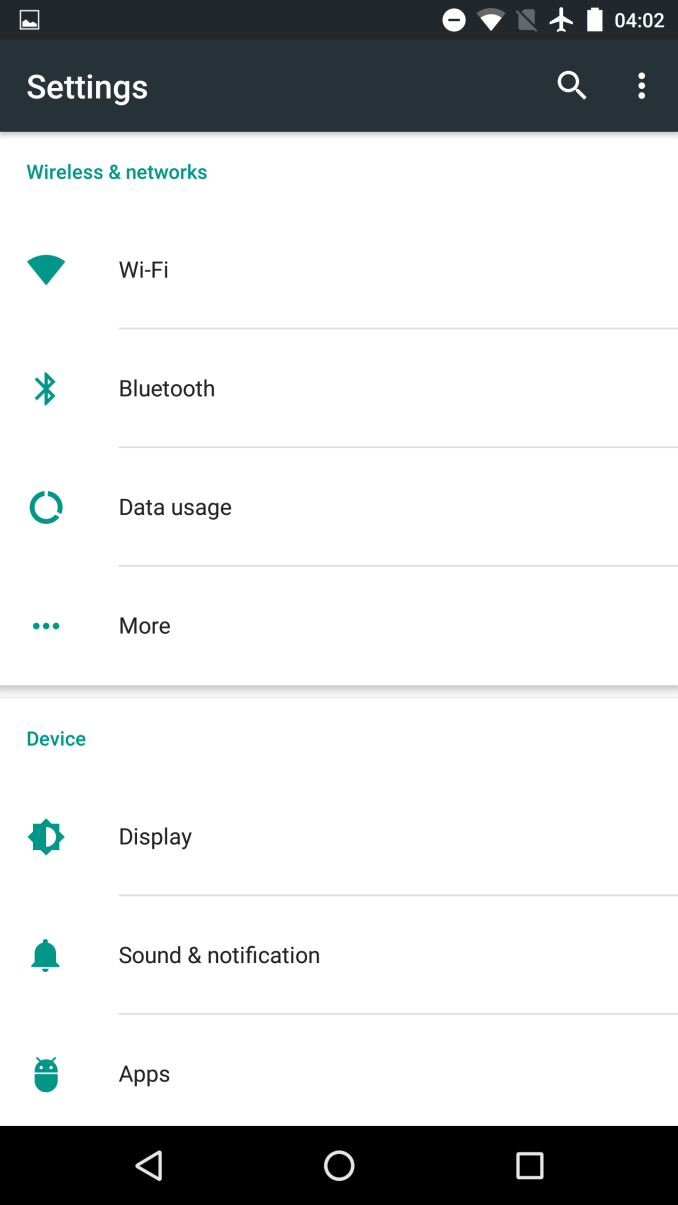









219 Comments
View All Comments
hfm - Thursday, December 17, 2015 - link
Muscle memory is easily learned in short order. Took me a week or two switching from two years of an N5 to get used to the differences. I always ignore those parts of reviews unless it's an obvious exceptionally bad UX choice. These weren't.Nightfall983 - Wednesday, December 16, 2015 - link
I don't understand your need about stock Android not having brightness slider in the notification shade. Swipe the shade down with 2 fingers (or pull down twice), and is right there.hfm - Thursday, December 17, 2015 - link
Not to mention turning off adaptive brightness will get the phone to 500 nits. I leave it on though.. But for this review where numbers are thrown around it should have been done.ChronoReverse - Wednesday, December 16, 2015 - link
Hi Andrei, nice review. You may want to explore /system/etc/thermal-engine.conf to see how the software level thermal throttling is configured. It's pretty interesting how core shutdown and frequency limiting is configured with respect to the temperature. Interestingly enough, GPU throttling is tied to the main temperature sensor as well.You can even remove the file so that the phone relies solely on the fail-safe thermal throttling.
Jeff7181 - Wednesday, December 16, 2015 - link
Would have been nice to see the OnePlus phones in these benchmarks... especially battery life.GPz1100 - Wednesday, December 16, 2015 - link
How about the review including some details on phone call quality, signal reception, etc...?QinX - Wednesday, December 16, 2015 - link
Why? Who uses a phone to call someone and expect a clear reception these days?mystilleef - Wednesday, December 16, 2015 - link
I have both the Note 5 and the 6P and there is no way in hell I'd recommend the Note 5 over the 6P on any universe. The 6P has better battery life, better speakers (yes, contrary, to the reviewer, front facing speakers make a huge difference), better camera (especially low light indoor shots), better MEMORY MANAGEMENT, a better OS, and just a far better user experience.Anyone telling me TouchWiz is better than Stock Android is just delusional. I can't take that person seriously, and I don't think anyone should. TouchWiz has horrible, horrible, horrible memory management especially on the S6 and Note 5. If you enjoy your browser tabs and apps reloading every time you blink, or you fancy random crashes due to memory mismanagement, get the Note 5.
Yes, I own the Note 5, and used it exclusively before I got the 6P.
The ONLY thing great about the Note 5 are the camera and display. That's it. TouchWiz is a curse to Android so much so that there are rumors that Samsung is in talks with Google to help them fix, or optimize, TouchWiz.
I choked on my food when Andrei recommended the Note 5 over the 6p for non-US users. Are you serious, Andrei? Did you use the Note 5 for any extended period of time? The only way I can recommend the Note 5 is if you're willing to flash CM on it.
The Note 5 has been one of the most unstable and unreliable Android devices I've ever used. I regretted selling my Nexus 6 for it. I read all the hype here and on the Internet about the Note 5 and fell for it. As a matter of fact, I plan on getting a Nexus 6 as a backup device and using it instead of the Note 5. Heck even the Nexus 6 performs better than the Note 5, and no one can convince me that TouchWiz is not the culprit.
In what universe is TouchWiz a better user experience than stock Android? Slide down the notification drawer on your 6p and do the same on your Note 5, that's all you need to know about the user experience of either devices. And I'm not even going to talk about the stutter and lag that begins to creep in after a few days of using any TouchWiz device.
I enjoyed the review, but sheesh, it's hard for me to trust the taste or opinion of anyone recommending TouchWiz over stock Android. That, unfortunately, tainted the review for me. A review I'd have otherwise held in high regard.
VnnAmed - Wednesday, December 16, 2015 - link
And if you need to flash CM on Note 5 remember that you will trip KNOX. Or just staywith N6P and flash away since their warranty is not bootloader state dependent. @Andrei Frumusanu One thing that this review didn't mention is that Nexus devices are flash friendly. Why would I buy one of those if not for long-term support and ability to change ROMs? And I understand that these articles are for normal people, but are they now? I'm classified as a nerd by fellow humans and even I don't understand every aspect of this review. Especially the screen part gets me confused BTW but back to the point, you said that you don't like where the back button is. Well most ROMs will have an option to change that, heck even a ROM for my M7 has it. Buying a Nexus phone is entering into the world of customization especially because these phones are semi-development devices. So while this is a review I've been waiting for and it's actually more beefy than I expected (good, I like them beefy reviews) especially in the hardware department, it falls short when explaining why would one pick Nexus over some other device. And my answer to that is it's because of freedom to change most of the settings just by typing few lines of code. And even if like me someone is not very good at that there are thousands of devs that do it everyday and allow us puny humans to download their work for free. So in the end just a short comparison from the other side of the fence. I live in Europe too. And it's not the nice and rich western Europe either. I'm poor and poor tech enthusiasts can't allow themselves to throw money around. So if I am faced with a choice between S6 and N6P I will with certainty choose the latter. Why you may ask? Because I will happily use Android 8 or whatever while Samsung will say something like "you want new Android on S6? We're sorry, we can't pull miracles with these puny 3 gigs of RAM". And when S6 will be stuck on some buggy release of Android 7.1.2 I will be flashing Official Exodus ROM Android 9 for Angler. Because even if google falls short, devs rarely do, and that's the true power of a Nexus device. P.S. Remember N4? It has fully working AOSP marshmallow.phoenix_rizzen - Wednesday, December 16, 2015 - link
Just curious why you specify the wireless as being dual-band, when it's more than implied by the standards supported.802.11b and 802.11g are 2.4 GHz only. 802.11a and 802.11ac are 5 GHz only.
Thus, listing 802.11a/b/g/n/ac support means it's dual-band, 2.4 GHz and 5 GHz. It can't be anything else.
If it only supports 802.11n (or 802.11b/g/n), then it makes sense to specify whether it's 2.4 GHz only, or 2.4 GHz and 5 GHz, as n works in both bands.